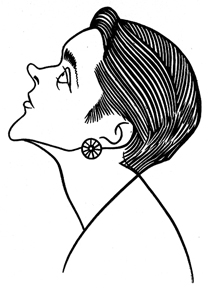In this chapter from his 1932 book, Times Square Tintypes, Broadway columnist Sidney Skolsky profiles stage actress Eva Le Gallienne.
IN GOD’S IMAGE
EVA LE GALLIENNE was born January 11, 1899, as the Bow bells of London were tolling seven. She is five feet four and weighs 128 pounds.
Her father is Richard Le Gallienne, the poet. Her mother, Julie Norregaard, a journalist. After they separated she went to Paris with her mother. Lived there until the age of thirteen, when she returned to London and enrolled in Sir Herbert Beerbohm Tree‘s Academy. It was here that Lyall Swete saw her and presently she made her London début in The Laughter of Fools.
At an affair she always requests the orchestra to play a tango.
She sews well. Love to iron her shirtwaists.
Left England for America to play in The Laughter of Fools for David Belasco. After two weeks of rehearsals the play was shelved.
Likes very sheer stockings and suéde shoes. Wears suéde gloves, always making it a point to buy them a size too large.
Her first appearance on the American stage was with Harrison Grey Fiske in Mrs. Boltay’s Daughter. Richard Le Gallienne, who hadn’t seen her since she was three, attended a performance. She had the rôle of a colored maid. Mr. Le Gallienne on seeing her exclaimed: “My God! Is that my daughter?”
She plays the piano, the guitar (gypsy and Spanish), the harp and the piccolo.
The members of her theatrical troupe call her “Saint Eva.” On the opening night of a play she sends every woman in the company a box of flowers. Every man receives a gardenia.
Her suits are short, while her evening dresses sweep the floor.
Whenever she goes to the theater she insists upon sitting in the first row.
Seldom touches hard liquor. Her taste is for wines. Prefers French cooking to any other style and eats almost a basketful of fruit a day. She adores ripe figs.
When eleven years old she made a copy of Mme. Bernhardt‘s memoirs in longhand. It required two volumes and a year’s labor. When Sarah Bernhardt heard of this she asked to see her and wrote a tribute on the flyleaf of the first volume. A copy of this now hangs in Miss Le Gallienne’s dressing room.
Former President Coolidge selected her as, next to Lindbergh, the outstanding person of 1928.
Her favorite cultivated flower is the camellia. She loves to pick wild flowers.
Has a wonderful collection of antique jewelry. Always wears earrings. One of her choice possessions is a cross made of emeralds. She wears this dangling from a silver chain which girdles her black velvet evening gown.
She owns a car and operates it herself. She gets a big kick out of driving in traffic.


